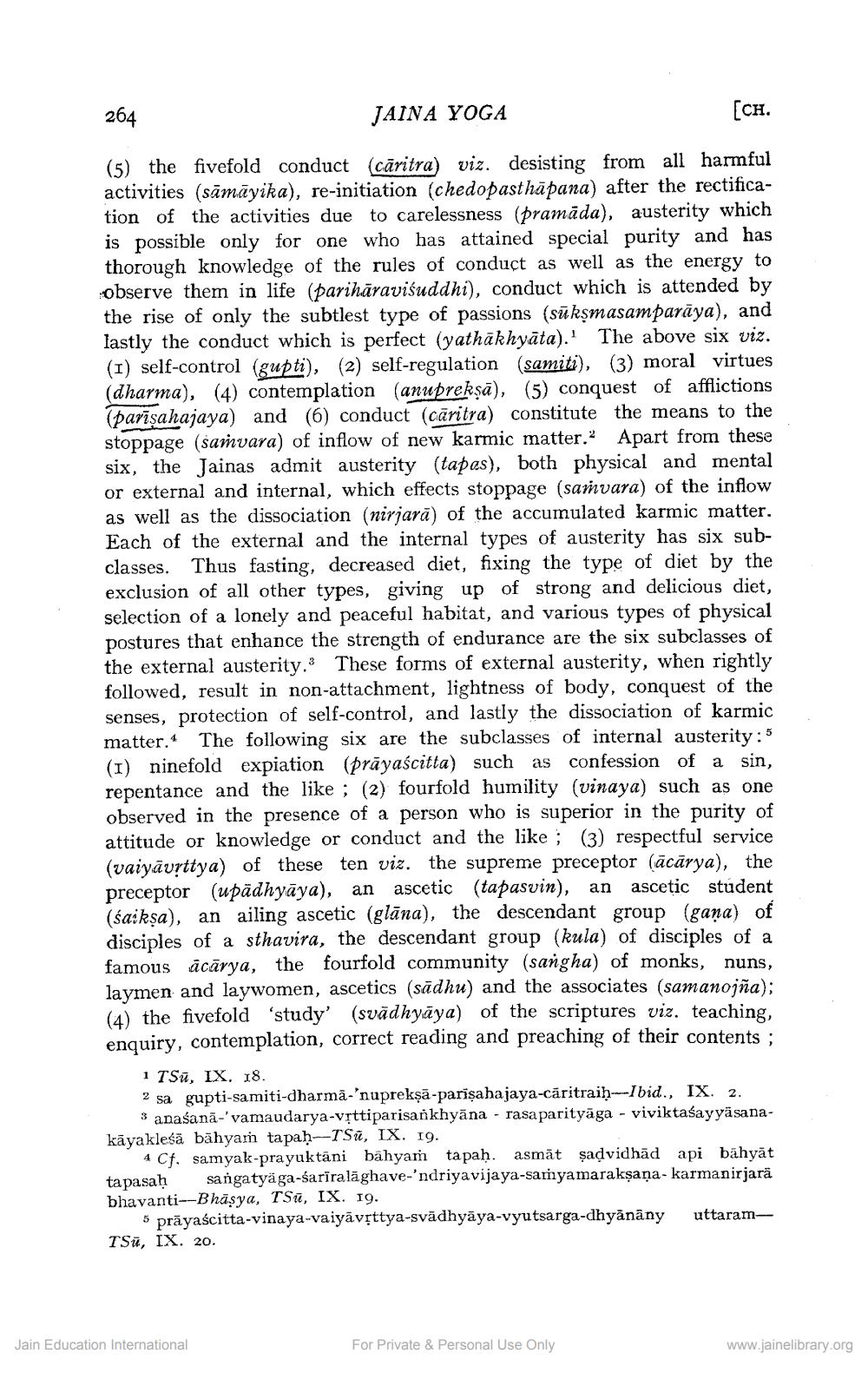________________
264
JAINA YOGA
[CH.
(5) the fivefold conduct (căritra) viz. desisting from all harmful activities (sāmāyika), re-initiation (chedopasthāpana) after the rectification of the activities due to carelessness (pramāda), austerity which is possible only for one who has attained special purity and has thorough knowledge of the rules of conduct as well as the energy to observe them in life (parihāraviśuddhi), conduct which is attended by the rise of only the subtlest type of passions (sūksmasamparāya), and lastly the conduct which is perfect (yathākhyāta). The above six viz. (1) self-control (gupti), (2) self-regulation (samiti), (3) moral virtues (dharma), (4) contemplation (anupreksā), (5) conquest of afflictions (parīsahajaya) and (6) conduct (caritra) constitute the means to the stoppage (samvara) of inflow of new karmic matter. Apart from these six, the Jainas admit austerity (tapas), both physical and mental or external and internal, which effects stoppage (sarvara) of the inflow as well as the dissociation (nirjarā) of the accumulated karmic matter. Each of the external and the internal types of austerity has six subclasses. Thus fasting, decreased diet, fixing the type of diet by the exclusion of all other types, giving up of strong and delicious diet, selection of a lonely and peaceful habitat, and various types of physical postures that enhance the strength of endurance are the six subclasses of the external austerity. These forms of external austerity, when rightly followed, result in non-attachment, lightness of body, conquest of the senses, protection of self-control, and lastly the dissociation of karmic matter. The following six are the subclasses of internal austerity: 5 (I) ninefold expiation (prayascitta) such as confession of a sin, repentance and the like ; (2) fourfold humility (vinaya) such as one observed in the presence of a person who is superior in the purity of attitude or knowledge or conduct and the like ; (3) respectful service (vaiyavrttya) of these ten viz. the supreme preceptor (ācārya), the preceptor (upādhyāya), an ascetic (tapasvin), an ascetic student (saikşa), an ailing ascetic (glāna), the descendant group (gana) of lisciples of a sthavira, the descendant group (kula) of disciples of a famous ācārya, the fourfold community (sangha) of monks, nuns. laymen and laywomen, ascetics (sādhu) and the associates (samanojña); (4) the fivefold 'study' (svädhyāya) of the scriptures viz. teaching, enquiry, contemplation, correct reading and preaching of their contents;
1 TSū, IX, 18. 2 sa gupti-samiti-dharma-'nuprekṣā-parişahajaya-căritraih-Ibid., IX. 2.
3 anašanā-'vamaudarya-vittiparisankhyāna - rasa parityāga - viviktaśayyäsanakāyakleśā bāhyam tapaḥ--TSü, IX. 19.
4 Cf. samyak-prayuktāni bâhyam tapaḥ. asmāt şadvidhād api bāhyāt tapasaḥ sangatyäga-sariralāghave-'ndriyavijaya-sariyamarakṣaṇa-karmanirjarā bhavanti--Bhäsya, TSū, IX. 19.
5 prāyaścitta-vinaya-vaiyāvșttya-svādhyāya-vyutsarga-dhyānāny uttaramTSü, IX. 20.
Jain Education International
For Private & Personal Use Only
www.jainelibrary.org




